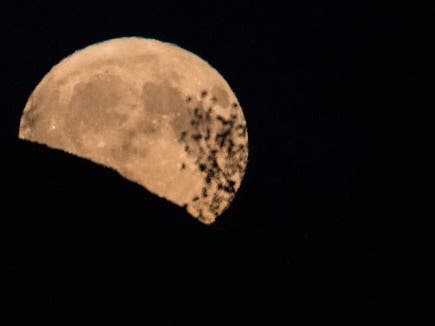Weather
Full Hunter’s Moon Rises Over Glenview, Dimming Orionid Meteors
The fireball-producing Orionid meteor shower and the October full hunter's moon compete for attention in the skies over Glenview.

GLENVIEW, IL — The Orionid meteor shower and the October full hunter’s moon have lead roles on the skywatching marquee this month, but the full moon gets top billing and is likely to blot out all but the brightest shooting stars over Glenview Wednesday night and Thursday morning.
And all that depends on the weather. AccuWeather, one of the country’s leading private weather forecasting companies, calls for an afternoon shower Wednesday with a 57 percent chance of rain. The high is 70 with a low of 55.
The Orionids are fast-moving meteors and sometimes produce fireballs, which could be bright enough to overcome the glare of moonlight. The moon will be about 100 percent full Wednesday night and will continue to shine brightly for several days. Moonrise in Glenview is at 6:32 p.m. local time.
Find out what's happening in Glenviewwith free, real-time updates from Patch.
The Orionids run from Oct. 2 to Nov. 7 and peak during the predawn hours Thursday. If you plan to be out and about to see this shooting star show, sunrise in Glenview is around 7:11 a.m. on Thursday.
The Orionid meteor shower produces about 20 meteors an hour. The October hunter's moon is full on Oct. 20, one of the peak dates, so only the brightest meteors will be visible.
Find out what's happening in Glenviewwith free, real-time updates from Patch.
The Orionids, produced by dust grains left behind by the ancient comet Halley, appear to radiate from the constellation Orion the Hunter but can be seen anywhere in the sky.
Skywatchers will have several more meteor showers to pick from through the remainder of the year:
Taurids, Nov. 4-5 and again Nov. 11-12: This is a long-running minor meteor shower that produces only about five or 10 shooting stars an hour. It's unusual not only because of its duration — it runs from Sept. 7 to Dec. 10 — but also because it consists of two distinct branches: the South Taurids, which peak Nov. 4-5, and the North Taurids, which peak Nov. 11-12.
The southern branch of the Taurid meteor shower is produced by the dust grains left behind Asteroid 2004 TG10, and the source of the northern branch is debris left behind by Comet 2P Encke. Both streams are rich in fireballs. At the peak, a new moon will make for dark skies. The shooting stars appear to radiate from the constellation Taurus, but you'll be able to see them anywhere in the sky.
Leonids, Nov. 16-17: The Leonid meteor shower, produced by dust grains left behind by comet Tempel-Tuttle, runs annually from Nov. 6-30. The Leonids have a cyclonic peak about every 33 years, when hundreds of meteors an hour can be seen — as last happened in 2001 — but this will be an average year with about 15 shooting stars an hour at the peak. A nearly full moon will be troublesome, but the Leonids are known for producing particularly bright shooting stars that even bright moonlight can't blot out. The meteors appear to originate from the constellation Leo.
Geminids, Dec. 13-14: The Geminid meteor shower, which runs from Dec. 4-17, is one of the best shooting star shows of the year. Produced by debris left behind by the Asteroid 3200 Phaethon — discovered in 1982 — the Geminids produce anywhere from 50 to 120 multicolored meteors an hour at the peak. A waxing gibbous moon at the peak will block some out, but they are so prolific and bright that the 2021 show should be a good one. The meteors appear to radiate from the constellation Gemini, but you'll be able to see them anywhere in the sky.
Ursids, Dec. 21: The Ursid meteor shower runs from Dec. 17-26 and always peaks around the winter solstice. The Ursids are fairly low-key, delivering five or 10 meteors an hour, but on rare occasions can produce outbursts of 100 or more meteors an hour. The meteors appear to come from the Ursa Minor constellation.
Get more local news delivered straight to your inbox. Sign up for free Patch newsletters and alerts.